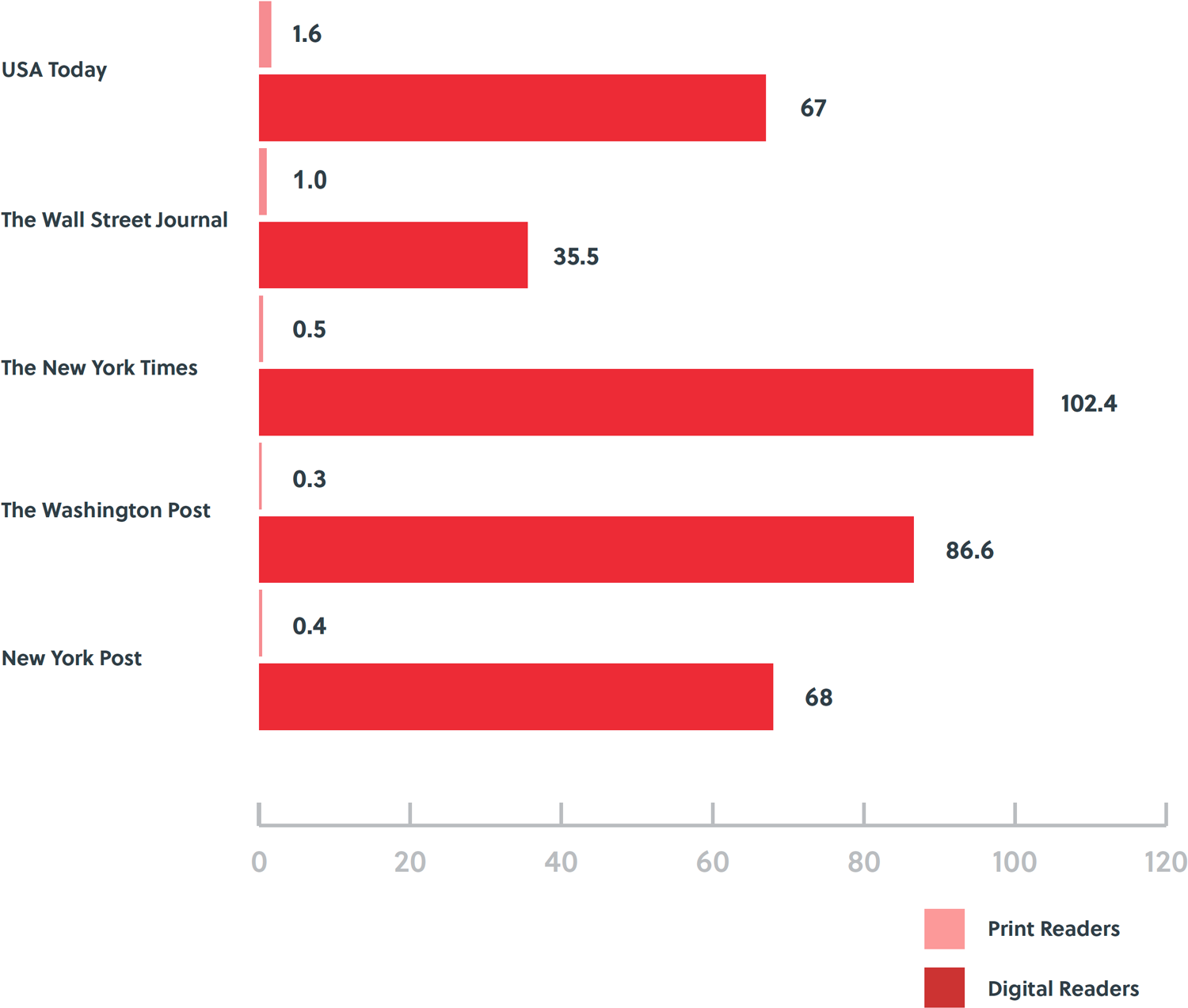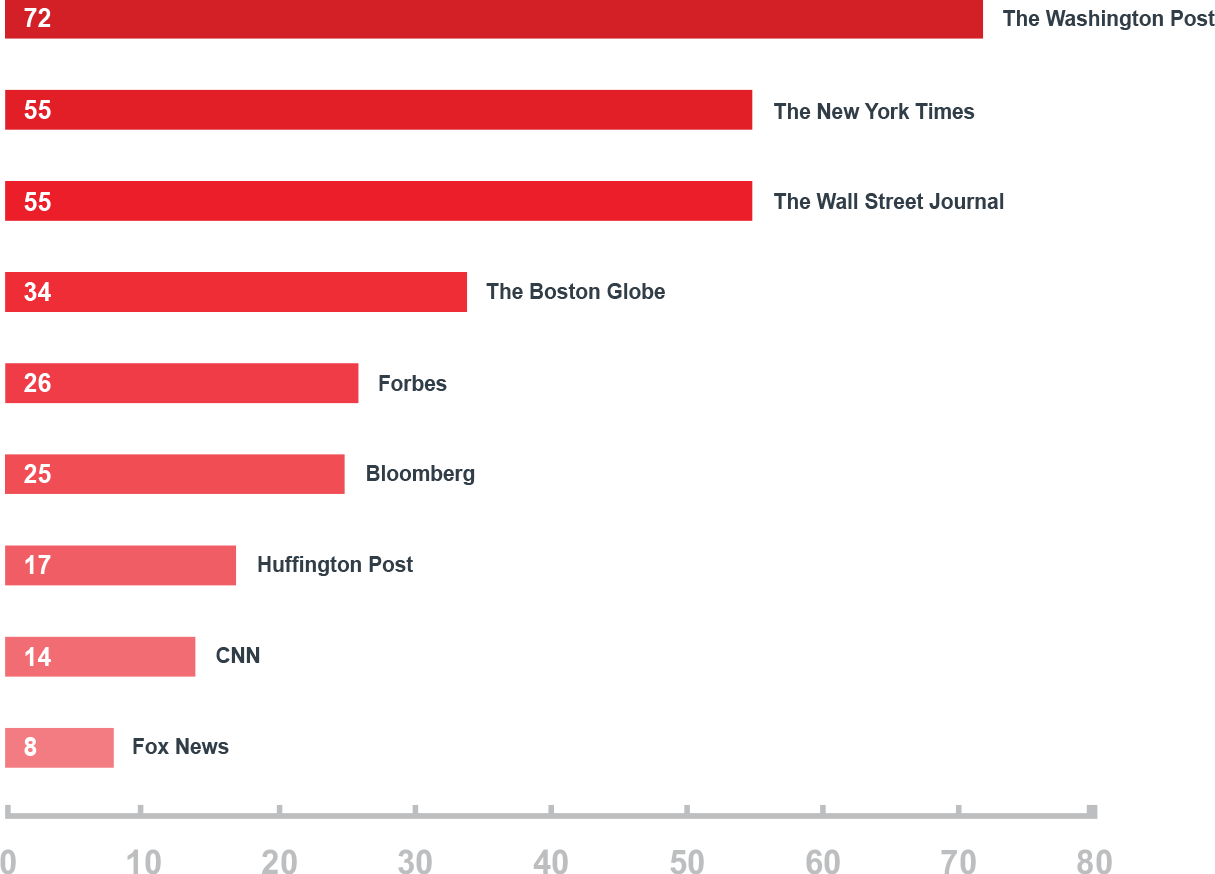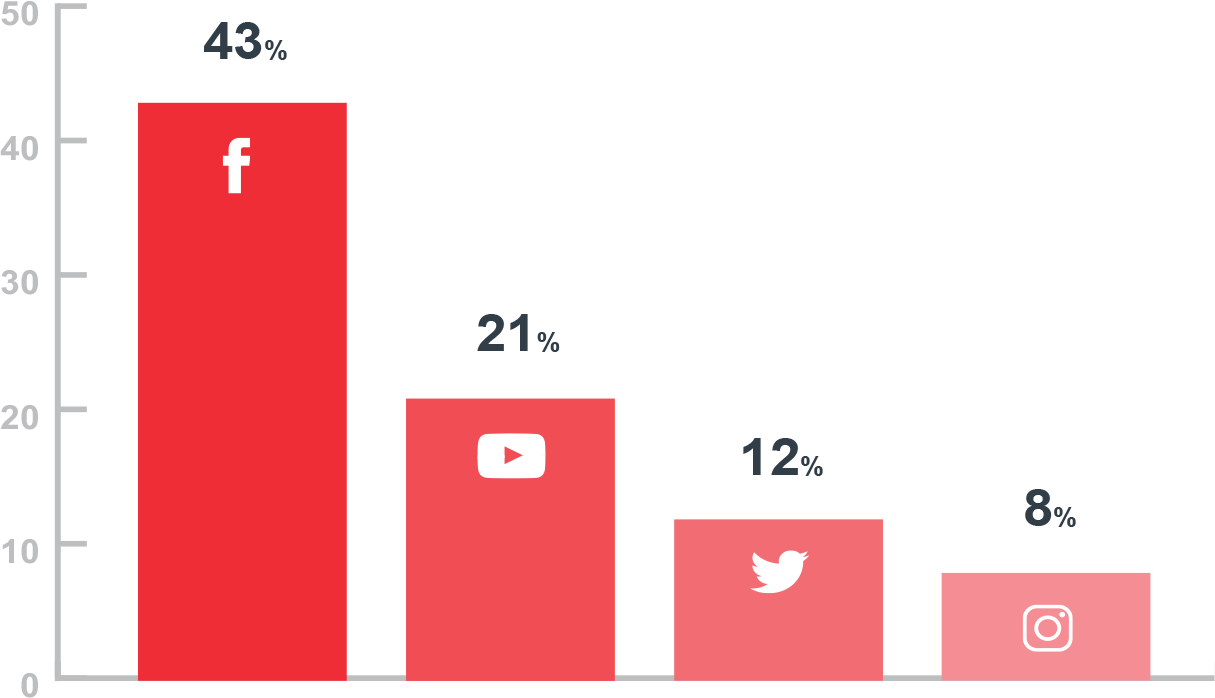
The State
Of The Op-Ed
Contents
- Introduction
- The Decline Of The Traditional Op-Ed
- The Rise of New Op-Ed Platforms
- Challenges for Thought Leaders
- Conclusion
Introduction
Since the 1970s, the op-ed has been one of the most powerful forms of earned media, with the ability to advance an individual’s or organization’s agenda, presence and reputation in their industry.
However, with the shifting media landscape and the rise in digital media, the traditional op-ed is giving way to new and innovative platforms for informed commentary. From 2008 to 2017, newsroom (newspaper, radio, broadcast and cable) employment in the U.S. dropped by 23%, with newspapers seeing the largest decline.1

⧉ Digital readership data, April 2019
⧉ Digital readership data, May 2019
⧉ Circulation data, Jan 2019
But media companies that are embracing digital platforms have grown; The New York Times Company, for example, generated more than $709 million in digital revenue in 2018, with a rise in both digital advertising revenue and online subscriptions. The company added 120 newsroom employees, bringing the total number of journalists to 1,600, the highest in its history.2 And in May 2019, the Boston Globe became the first local paper to have more digital subscribers than print.3 3 This shift toward a digital audience is also shifting the opportunities for opinion and commentary as well.
We conducted an analysis of the top U.S. newspapers by circulation and the top business publications to assess the state of the op-ed in the modern media era. Our analysis included both national and regional publications. Our research revealed that though opinion columns and editorials are still relevant for thought leadership voice amplification, many publications are adopting new mechanisms to supplement, and in some cases entirely replace the traditional op-ed model.
Executives, scholars and experts who want to remain actively engaged in thought leadership must be nimble and creative enough to adapt to the changing media landscape and embrace increasingly diversified modes of commentary.4
The Decline Of The Traditional Op-Ed
The predecessor of the modern op-ed first appeared in 1921, in the New York World. The page “opposite the editorials” published book reviews, society boilerplate and the diverse commentary of in-house columnists. In 1970, The New York Times published its first op-ed page, to which experts and members of the general public could submit their views on cultural and political discourse. The stated mission of the page was that “a contribution may be made toward stimulating new thought and provoking new discussion on our public problems.5 It has been referred to as the most valuable piece of real estate in American journalism.6
Over time, most major newspapers adopted the same model, and the op-ed rose to become a powerful earned-media tool for furthering thought leadership. But with the decline in print journalism and the advent of digital media, the op-ed is seeing a remarkable transformation.
Most publications today must grow their digital presence in order to compete for readers whose preferences are shifting from print to digital. While many are maintaining op-ed publication, in some cases, as newsrooms consolidate for cost efficiency and long-term sustainability, opinion sections are often the first to go. Traditional op-ed publication is especially declining in trade publications
With the advent of digital media, the op-ed is seeing a remarkable transformation.
While most national and large regional newspapers have maintained op-ed hosting, some media outlets have begun to shift away from the traditional op-ed model to adopt a contributor, or similar, model. This model does not allow for the publication of one-off op-ed style articles, but rather pieces written by contributors who are knowledgeable about the types of industries and topics regularly covered by the outlet.
Forbes
In 2017, the Forbes’ opinion section shut down “to increase the business magazine’s focus on its network of online contributors” which consists of nearly 2,000 approved non-staff writers. Forbes’ model allows these contributors to publish directly to Forbes.com. “As we strive to tell stories that have a point of view, the need for conventional opinion-style writing has lessened,” Forbes Media vice president of digital news Mark Coatney wrote in an internal email to staff.7 Instead of an open traditional op-ed model, Forbes now institutes a contributor platform to empower a diverse set of voices comprised of experts and freelance journalists who have a prescribed area of mastery. Over the past year, Forbes.com readership has increased 28% to 71.1 million visitors monthly.8 Other business outlets like Inc. and Fast Company have also adopted a contributor model.
Forbes.com reaches 71.1 million U.S. visitors — an increase of 28% in the past year.
Huffpost
In January 2019, the Huffington Post – a pioneer of digital media – shut down its Opinion section in order to invest in areas with higher audience engagement. A spokesman for the media outlet said, “HuffPost is investing its talents and resources to areas that have high audience engagement, differentiation and are poised for growth at a time when our mission means more than ever.”9 The site preserved a section dubbed “HuffPost Personal” for first-person essays that showcase the human experience.
Association of opinion journalists
The Association of Opinion Journalists (AOJ), the organization that represents editorial writers and columnists, saw a strong decline in membership over the past decade. In a span of seven years, the AOJ’s 500+ membership pool plunged by 55%. In 2017, the AOJ’s board of trustees decided to seek a merger with another professional organization because there were fewer than 200 members.10
The Rise of New Op-Ed Platforms
While many publications like the Washington Post, The New York Times, USA Today, The Wall Street Journal and Newsday continue to have distinguished Opinion sections, several new platforms have emerged that challenge the traditional op-ed and traditional media’s leadership in promoting public discourse. These platforms encourage diverse, entertaining and dynamic voices and creative expression.
Medium
The online publishing platform, Medium, has been described as “the digital version of a lot of things – a magazine, a stable of magazines, a PR news-wire, a social network based around writing, and so on.”11 Medium considers itself the modern version of the newspaper op-ed.
New platforms have emerged that challenge the traditional op-ed.
Platforms like Medium are disrupting the traditional op-ed model in the same way Craigslist disrupted classified advertising. Medium is aggregating opinion content with several valuable advantages over traditional platforms – contributors can publish as often as they like with no interference from the editorial gatekeepers of traditional media platforms.
In 2016 Fortune magazine moved its contributors network, Fortune Insiders, to Medium. Fortune Insiders calls itself “an exclusive group of contributors who share their ideas with our global online audience” and “a platform to mentor and pass on career advice and other wisdom to entrepreneurs who aspire to be extraordinary achievers.”12
Most national publications have recognized the opportunity for growing a native community on LinkedIn and have been receptive to the steady rise in users who use LinkedIn as a source for news and commentary. In a 2016 study, Forbes, Business Insider, Inc., The New York Times and The Wall Street Journal were among the top ten most shared sites as LinkedIn publishers – many of which publish pieces on or by thought leaders.
More Americans are using LinkedIn as a source for news and commentary.
Newsletters
The proliferation of daily, weekly or monthly newsletters distributed by top publications is reflected in the investment some thought leaders are beginning to make. Most top publications are now offering a selection of newsletters, focused on topics ranging from entertainment to politics to investment news. The New York Times newsletters reached over 14 million subscribers in 2018.13 Companies and individual thought leaders are also embracing the digital newsletter trend to target a specific audience and personalize the reader experience. Email automation and machine learning, which can predict and optimize the best send times and frequency, have helped fuel the newsletter renaissance.
Revue, an editorial newsletter platform, facilitates an average open rate above 50% – almost twice the industry average for media and publishing companies and in line with editorial newsletter publishers like The New York Times and The Economist.14 Industry changes have brought newsletters to the forefront as a conduit for building a direct relationship with readers and opportunities for thought leaders to weigh in on key topics.
Podcasts
The podcast space is being increasingly populated by major media outlets as a channel to connect with consumers in a new way. A CBS News survey of U.S. podcast listeners showed an increase of people listening to podcasts daily or multiple times a week from 15% in December 2017 to 23% in January 2019.15
This content explosion in the podcast genre as seen by major publications has only been amplified by Spotify’s and Google’s heavy investment in the podcast ecosystem in 2018. In the last year, The New York Times, The Washington Post, ABC News, The Guardian, Inc., and Slate have all introduced news podcasts that have gained traction.
Nearly a quarter of Americans listen to podcasts at least once per day.
In addition, USA Today, The Wall Street Journal, The Economist, and Bloomberg have launched technology and innovation podcasts, among other topic-specific shows, and are continuing to invest heavily in developing podcasts that drive traffic back to their news pieces. In the same way that news outlets are leveraging podcasts to position themselves as a key news source, industry leaders are following suit to connect with audiences directly and position themselves as thought leaders.

The New York Times podcast reaches two million listeners per day16 and is the top podcast in the U.S.17
| News Outlet | Podcast Name |
|---|---|
| The New York Times | The Daily |
| The Washington Post | Post Reports |
| ABC News | Start Here |
| The Guardian | Today In Focus |
| Inc. | Uncensored Inc. |
| Slate | What Next |
| USA Today | Talking Tech |
| The Wall Street Journal | Instant Message |
| The Economist | Babbage |
| Bloomberg Technology | Decrypted |
Video Op-eds
The video op-ed is gaining traction as a new platform, and thought leaders are increasingly capitalizing on the expansion of this new platform. Op-Docs, The New York Times editorial department’s award-winning forum for short, opinionated documentaries, accepts written pitches with representative footage. Similarly, The Wall Street Journal introduced an interview series in 2017 called “In the Elevator With,” featuring various CEOs interviewed by host, Joanna Stern.
CNN had 528 million digital news starts in 2018.
The Wall Street Journal now has a total of seven digital video platforms, on which an average of 51.9 million monthly video-driven stories are viewed – an average of 4.4 videos per viewer. Mic, a platform exclusively covering opinion and review pieces, frequently utilizes a video op-ed model with 3.30 million unique monthly visits. CNN leads mass digital viewership with 528 million digital news starts in 2018.18
Social Media
The state of digital outlets has propagated the use of social media platforms like Facebook and Twitter to release op-eds. In December 2018, social media outpaced print newspapers as a news source for the first time.19 Nearly nine-in-ten adults (93%) get at least some news online via mobile or desktop, and the average unique views per month among major digital outlets is over 21 million.
As digital-native news outlets adopt other outreach and engagement methods, they have increasingly leveraged social media to amplify the scope of their opinion pieces. According to a study conducted by the Pew Research Center, nearly all of these outlets have official pages or accounts on Facebook (100%), Twitter (100%), YouTube (94%) and Instagram (89%). 18 TechCrunch.

As digital-native news outlets adopt other outreach and engagement methods, they have increasingly leveraged social media to amplify the scope of their opinion pieces. According to a study conducted by the Pew Research Center, nearly all of these outlets have official pages or accounts on Facebook (100%), Twitter (100%), YouTube (94%) and Instagram (89%).
Reddit, Twitter and Facebook stand out as the sites where the highest portion of users are exposed to news – 67% of Facebook’s users get news there, as do 71% of Twitter’s users and 73% of Reddit users. Moreover, Internet users are now devoting almost 2 ½ hours on social media per day –nearly 40 minutes more per day than print press (0:43) and online press (1:01) combined.20
If thought leaders want to break through, they need a targeted and deliberate strategy for how to use social media to amplify their content. This includes a plan to build their networks to generate traffic, regular engagement with news and other social media influencers, and consistent, smart content that is relevant to their expertise. Generating original research is also an effective way to build a reputation on social media.
Two-thirds of Americans get news on social media.21
Regional Newspapers
While the content of many regional outlets, such as the Chicago Tribune or the Boston Globe, targets a specific geographic region, the reach of these papers is often as great or greater than many “mainstream” outlets. Savvy thought leaders should consider these publications as they begin to reach more mainstream audiences. Large regionals provide unique opportunities for readership reach and targeted audiences. For example, the San Francisco Chronicle may be a more impactful placement for a tech-focused op-ed than a national newspaper, just as the Houston Chronicle might be a better choice for an op-ed on energy. 20 Pew
Challenges For Thought Leaders
The trajectory of investments made by national publications reflects an industry-level shift in the shape and form of earned media. This calls for increased agility and adaptability on the part of thought leaders and a willingness to explore new earned media platforms in addition to a steady and regular flow of traditional content.
The op-ed is evolving, learn how to evolve with it.
Download the rest of this whitepaper for free and read about the challenges thought leaders face around op-eds and our actionable conclusions.
